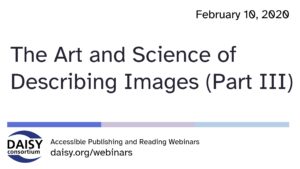The Art and Science of Describing Images Part Three (W)
 In our series of free webinars February 10th saw the 3rd session focusing on image description: in the series entitled, The Art and Science of Describing Images. This webinar focused on 3 specific types of complex images with speakers Huw Alexander and Valerie Morrison showing us all how they approach these seemingly daunting areas.
In our series of free webinars February 10th saw the 3rd session focusing on image description: in the series entitled, The Art and Science of Describing Images. This webinar focused on 3 specific types of complex images with speakers Huw Alexander and Valerie Morrison showing us all how they approach these seemingly daunting areas.
This page contains:
Full Video of the Webinar
Speakers
- Richard Orme, The DAISY Consortium—host and chair
- Valerie Morrison—Center for Inclusive Design and Innovation at Georgia Institute of Technology
- Huw Alexander—textBOX Digital
Session Overview
Huw Alexander opened this session by giving us a brief resume of what the webinar will cover. Continuing on from Part Two of this series this session will focus on 3 specific types of complex image: Artwork, Anatomy and Assessment.
Artwork
As with all images, Valerie advocates beginning with an overview of the artwork piece, the title together with a brief resume of the main components. For a more complex description it is imperative to consider the context for which you need the description. This may include:
- The painting style
- The color and composition
- The style of the figures
- Allegorical messaging
- Influences
- Historical notes
To include all of these notes within your alt text image description would be far too much and if there is a need for lengthy content here then it is better to write an extended description.
Huw explained “Sector Description” – by breaking down a painting into sections you can take the reader on a journey. This can be done in a number of ways: linear, clock face style, compass etc. Using this approach helps to create an immersive experience for the reader.
Valerie and Huw used some excellent examples to demonstrate how effective these techniques can be when describing complex images.
Anatomy
Making sure that you convey the relevant and precise elements of an anatomical image is likely to be an exacting process. Valerie made the point that you have to think very carefully about what to include in your description, because simply labelling all the parts often isn’t good enough. It doesn’t take into consideration the context in which the image is being used and it is far more useful to consider the following:
- The name of the structure itself
- The shape
- The location
- Proximity
Huw’s sectoring approach works very well with anatomical images, deciding what needs to be retained and considering the visual impact of the image itself.
Assessment
Images that are used in assessments, quizzes and tests can be extremely hard to recreate in description form and Valerie suggested that assessors consider an egalitarian approach here. By thinking of alternative ways to test knowledge you may be far more successful in creating a useful testing scenario. The example used was a geography question on the silhouettes of countries and the following might work equally well:
- Questions about the size and shapes of countries
- An essay question
- Tactile graphics
All of these would test knowledge in various ways and offer an alternative to the silhouette question!

